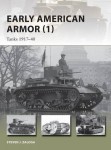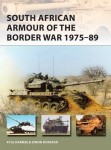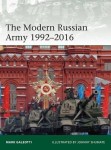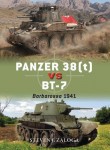Wednesday, June 22, 2016 - 04:45 AM UTC
Osprey has several new books by their heavy hitters (Estes, Zaloga, Dunstan, and Galeotti) coming out for the next several months. WW2, Vietnam, modern, etc. in the standard Osprey format.
M50 Ontos and M56 Scorpion 1956-70: US Tank Destroyers of the Vietnam War
Designed in the 1950s, the US Marines' M50 Ontos and the US Army's M56 Scorpion were both intended to be fast, light, air-droppable tank-killers for the Cold War battlefield--an answer to the cumbersome and ineffective World War II-vintage tanks that had taken to the battlefield during the Korean War. Although they shared the aim of bringing light, mobile, and lethal antitank firepower to the infantry, the two vehicles varied wildly in design to cater for their unique mission demands. They first saw service in the Lebanon intervention of 1958 but it was in the Vietnam War that they made their name, with the M50 Ontos seeing intense combat action in the 1968 Battle of Hue.
Detailed illustrations and expert analysis provide the reader with a comprehensive history of these deadly antitank vehicles, from early development through to their combat history and the eventual disbandment of the Marine Corps' last antitank battalion with M50A1s in 1971.
Early American Armor: Tanks 1916-40
Between the two world wars, the United States contributed significantly to the evolution of the tank, a weapon invented by the British and the French seeking to break through the lines of German trenches. From the employment of the French Renault FT and British Mark V during their involvement in World War I, the United States branched out with its own indigenous designs, including the M1 Cavalry Car and the M2 Light and Medium tanks, the precursors to the Stuart and Grant tanks of World War II. Tank designers in this period faced unique challenges, and the story of early American armor is littered with failures among the successes.
Featuring previously unpublished photos and fully illustrated throughout, Early American Armor (1): Tanks 1917–40 is essential reading for anyone interested in American armor, or in the development of tank design.
South African Armour of the Border War 1975-89
The Border War saw the biggest armored battles in Africa since World War II. Starting as a counterinsurgency operation by the South African Defence Force (SADF) against the South West Africa People's Organization, South Africa became embroiled in the complex Angolan Civil War, where they came up against enemies well supplied with equipment and armored vehicles from the Soviet Union.
With the aid of stunning illustrations and photographs, this study details the characteristics, capabilities, and performance of the wide variety of armored vehicles deployed by the SADF, from the Eland armored car to the Ratel infantry fighting vehicle and the Olifant tank. Designed for the unique conditions of the region, South Africa's armor was distinctive and innovative, and has influenced the design of counterinsurgency armored vehicles around the world.
The Modern Russian Army 1992-2016
Since the collapse of the Soviet Union, Russia's army has undergone a turbulent transformation: from the scattered leftovers of the old Soviet military, through a period of shocking decay and demoralization, to the disciplined force and sophisticated “hybrid war” doctrine that enabled Vladimir Putin to seize Crimea virtually overnight in 2014.
Using rare photographs and full-color images of the army in action, profiles of army leaders and defense ministers, as well as orders of battle and details of equipment and dress, this is a vivid account of the army's troubled history and of its current character, capabilities and status.
Panzer 38(t) vs BT-7: Barbarossa 1941
The tank battles in the Soviet Union during the summer of 1941 were the largest in World War II, exceeding even the more famous Prokhorovka encounter during the Kursk campaign. Indeed, they were largest tank battles ever fought.
This book examines two evenly matched competitors in this conflict, the German Panzer 38(t) and the Soviet BT-7. Both were of similar size, armed with guns of comparable firepower, and had foreign roots--the Panzer 38(t) was a Czechoslovak design and the BT-7 was an evolution of the American Christie tank. With full-color artwork and archive and present-day photography, this absorbing study assesses the strengths and limitations of these two types against the wider background of armored doctrine in the combat of Operation Barbarossa.
Designed in the 1950s, the US Marines' M50 Ontos and the US Army's M56 Scorpion were both intended to be fast, light, air-droppable tank-killers for the Cold War battlefield--an answer to the cumbersome and ineffective World War II-vintage tanks that had taken to the battlefield during the Korean War. Although they shared the aim of bringing light, mobile, and lethal antitank firepower to the infantry, the two vehicles varied wildly in design to cater for their unique mission demands. They first saw service in the Lebanon intervention of 1958 but it was in the Vietnam War that they made their name, with the M50 Ontos seeing intense combat action in the 1968 Battle of Hue.
Detailed illustrations and expert analysis provide the reader with a comprehensive history of these deadly antitank vehicles, from early development through to their combat history and the eventual disbandment of the Marine Corps' last antitank battalion with M50A1s in 1971.
Early American Armor: Tanks 1916-40
Between the two world wars, the United States contributed significantly to the evolution of the tank, a weapon invented by the British and the French seeking to break through the lines of German trenches. From the employment of the French Renault FT and British Mark V during their involvement in World War I, the United States branched out with its own indigenous designs, including the M1 Cavalry Car and the M2 Light and Medium tanks, the precursors to the Stuart and Grant tanks of World War II. Tank designers in this period faced unique challenges, and the story of early American armor is littered with failures among the successes.
Featuring previously unpublished photos and fully illustrated throughout, Early American Armor (1): Tanks 1917–40 is essential reading for anyone interested in American armor, or in the development of tank design.
South African Armour of the Border War 1975-89
The Border War saw the biggest armored battles in Africa since World War II. Starting as a counterinsurgency operation by the South African Defence Force (SADF) against the South West Africa People's Organization, South Africa became embroiled in the complex Angolan Civil War, where they came up against enemies well supplied with equipment and armored vehicles from the Soviet Union.
With the aid of stunning illustrations and photographs, this study details the characteristics, capabilities, and performance of the wide variety of armored vehicles deployed by the SADF, from the Eland armored car to the Ratel infantry fighting vehicle and the Olifant tank. Designed for the unique conditions of the region, South Africa's armor was distinctive and innovative, and has influenced the design of counterinsurgency armored vehicles around the world.
The Modern Russian Army 1992-2016
Since the collapse of the Soviet Union, Russia's army has undergone a turbulent transformation: from the scattered leftovers of the old Soviet military, through a period of shocking decay and demoralization, to the disciplined force and sophisticated “hybrid war” doctrine that enabled Vladimir Putin to seize Crimea virtually overnight in 2014.
Using rare photographs and full-color images of the army in action, profiles of army leaders and defense ministers, as well as orders of battle and details of equipment and dress, this is a vivid account of the army's troubled history and of its current character, capabilities and status.
Panzer 38(t) vs BT-7: Barbarossa 1941
The tank battles in the Soviet Union during the summer of 1941 were the largest in World War II, exceeding even the more famous Prokhorovka encounter during the Kursk campaign. Indeed, they were largest tank battles ever fought.
This book examines two evenly matched competitors in this conflict, the German Panzer 38(t) and the Soviet BT-7. Both were of similar size, armed with guns of comparable firepower, and had foreign roots--the Panzer 38(t) was a Czechoslovak design and the BT-7 was an evolution of the American Christie tank. With full-color artwork and archive and present-day photography, this absorbing study assesses the strengths and limitations of these two types against the wider background of armored doctrine in the combat of Operation Barbarossa.
Click Star to Rate
5 readers have rated this story.
THIS STORY HAS BEEN READ 8,692 TIMES.
| Osprey Publishing Reviews | MORE |
| The PIAT by Randy L Harvey | of 1 ratings, 100% found this helpful | |
| German Super-Heavy Siege Guns by Randy L Harvey | |
| Glorious Glosters by Randy L Harvey | |
| German Super-Heavy Siege Guns by Randy L Harvey | of 1 ratings, 100% found this helpful | |
| Combat Vehicles of Russia’s SP by kylie newton | |
| Warsaw 1920 by kylie newton | of 1 ratings, 100% found this helpful | |
| Imjin River 1951 by Randy L Harvey | of 1 ratings, 100% found this helpful | |
| The Browning High-Power Pistol by Randy L Harvey | of 1 ratings, 100% found this helpful | |
| Australian Army 1976-2016 by Paul Truhe | of 1 ratings, 100% found this helpful | |
| Verdun 1916 by Randy L Harvey | of 2 ratings, 100% found this helpful | |
| Operation Eagle Claw 1980 by Randy L Harvey | of 1 ratings, 100% found this helpful | |
| Hotchkiss Machine Guns by Randy L Harvey | of 1 ratings, 100% found this helpful | |
| The Arisaka Rifle by Randy L Harvey | of 1 ratings, 100% found this helpful | |
| Division Leclerc by Randy L Harvey | of 1 ratings, 100% found this helpful | |
| Heroes of Telemark by Randy L Harvey | of 1 ratings, 100% found this helpful | |













Comments